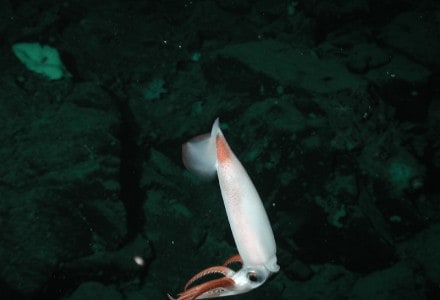
Armhook Squid Facts
- Firstly, Armhook Squid is the collective common name of an entire family of squid. Furthermore, a total of 19 known species exist within this family. The species all share multiple characteristics.
- Rather unfortunately, detailed knowledge of the amazing creature remains scarce. This regrettable lack of precise information principally occurs due to the nature of the habitats of the members of this group.
- Further, for the moment, the IUCN lists only one of these member species on its Red List. And even that one lists as Least Concern. This mainly occurs because all of the species in the group seem to still be quite numerous.
Related Articles
Glass Squid Striped Pyjama Squid Flapjack Octopus
Armhook Squid Physical Description
First of all, all known varieties of Armhook Squid appear physically extremely similar. These fascinating creatures also remain quite popular for several distinct deviations from the norm among squid.
That holds true because suckers on the arms lie into four distinct rows. However, among the majority of squid species, two rows are typical. This sets the Armhook Squid distinctly apart from its relatives.
Additionally, some of the suckers have developed into small hooks. In some species, both genders possess these hooks. Yet in others, sexual dimorphism is present, because in those species only the females have these.
Further, one species also evolved to possess photophores which sit around the creature’s eyes. Finally, most species appear a purple-brown or dark red in color.
- Kingdom: Animalia
- Phylum: Mollusca
- Class: Cephalopoda
- Order: Oegopsida
- Family: Gonatidae
Armhook Squid Distribution, Habitat, and Ecology
Most notably, the majority of species of Armhook Squid prefer to inhabit the area near continental shelves. Between the various members of the group, this includes the Pacific, Atlantic, and Antarctic regions.
In addition, each of these usually stays within the pelagic zone of its native ocean. Depending upon the region, however, this zone of habitation may extend to as deep as 14,764 ft (4000 m).
Also, it tends to remain in deeper waters during the day, preferring darkness. At night, it will often migrate to the surface where it will feed upon a variety of small fish and crustaceans. But it sometimes even engages in cannibalism when prey is scarce.
Naturally, prey varies somewhat, depending on the region it inhabits. However, this typically consists of fish and crustaceans. Finally, its own primary predators include elephant seals and several species of whales. Among the most notable of these are the Minke Whale and the Orca.
Species Sharing Its Range
Blue Shark Black Sea Hare Maui Dolphin
Check out our other articles on 6 Fabulous European Lepidoptera, Living Stones, Enchanted Well, Puffin, Socotra Bluet, Leaping Lesbian Lizard, Black Rain Frog

